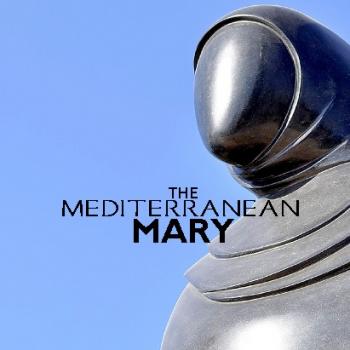
“Image”by frecklebaum is licensed under CC BY 2.0
Reading about Jesus, Mary, and Martha in “Luke” takes work if it is to be done respectfully.
Reading the Gospels can be a tricky, messy business. What is really going on in yesterday’s Gospel from “Luke” about Jesus entering Martha’s house and teaching Mary? In trying to answer that question, the creative juices begin flowing in many readers’ minds with all sorts of possible (and impossible) answers. How do we gauge them?
Reading Our Baggage Into the Story
We always come to what we read with baggage, don’t we? We all have biases that are cultural, ethnic, political, philosophical, theological, and more. Don’t think that’s easy to drop. Even in the most critical of scholars, this baggage shapes how they read these stories, and can distort what they were intended to convey.
One can find plenty of imaginative proposals as to what the story meant, all of which demand a further question: “Is this culturally plausible?”
The Gospel called “Luke”—like all the Scriptures—comes from a time and culture alien to ours. Interpreting such documents must be a multidisciplinary affair. How can we discover what these ancient texts meant to their original audience?
Considerate Gospel Reading
Biblical scholars must master a range of disciplines for this challenge of respectful reading. These include history, proficiency of ancient and modern languages, literary theory, and theology and philosophy from times ancient, medieval, and modern. All these tools are wonderful and needed, but without the social sciences joining and informing them, the interpreter will not find the original meaning of the Sacred Texts.
Biblical interpretation must a type of cross-cultural study as Bible reading is an example of cross-cultural communication. Since meanings derive from the social systems that enculturate and socialize human beings, in order to understand biblical meanings, we need the social sciences to illuminate the cultural world of the Bible. Otherwise our reading will necessarily produce misunderstanding or non-understanding.
Ugly Readings
The great Albert Schweitzer (d. 1965) pinpointed the danger of creating idealized autobiographies of Jesus. Even the greatest, most dispassionate and critical of scholars fall prey to this. When a capitalist reads the Gospels, amazingly, Jesus looks awfully capitalistic. But when a socialist reads the Gospels, Jesus astonishingly appears to be socialist. When an American looks at Jesus, gasp!—Jesus looks American—individualistic, introspective, someone who was free and thought for himself, ultimately, a self-motivated winner.
American believers are like believers from everywhere else in the world in that they cannot stand a Jesus who is not buying their own culture’s values. So, whether innocently or insidiously, we all make a congenial Jesus as a stand-in for the real deal. This is because we can do business with our various cultural congenial Jesuses—Nigerians with a Nigerian Jesus, Colombians with a Colombian Jesus, Russians with a Russian Jesus, Chinese with a Chinese Jesus, and Americans with an American Jesus.
The Messy Prefix “IN”
Do we take the prefix “IN” of IN+carnation seriously? If we are Christian, we cannot afford not to. Because if God in Christ has not assumed some aspect of being human, we are not redeemed. Jesus is really human, folks. We ought to beware Docetism, particularly crude quasi-Docetic forms that favor our ideologies and cultural values. Docetism is that most ancient heresy that turns Jesus’ humanity into a make-believe.
Taking the “IN” of the Incarnation seriously demands we recognize that like all human persons Jesus was socialized and enculturated. This happened to him in a first century eastern Mediterranean society. Therefore, we ought to ask how much globalism, universalism, scientism, post-industrial urban life, 19th century abundance, and 20th century superabundance did he taste? The answer must be zero.
Is human existence pan-cultural, or always culturally specific? Of course, it is the latter. Given the prepaschal Jesus’ culturally-specific life and his historical and socio-economic situation, what could he know of Justinian’s Code of Ethics, Arab-European Scholasticism, Justinian’s Code, the Renaissance, the Enlightenment, international law, severe monotheism, Talmudic Jewish religion, or anything one would attribute to a William Buckley or a Noam Chomsky? Careful with your Docetic parachute! Incarnation is messy!
Reading in Light of Today’s Crises
So what do you think this story with Jesus, Mary, and Martha is really about? We definitely have a problem in our current Church situation where women do not have a legitimate voice. If you cannot see that then you are part of the problem. We need to taste the truth of this, especially people with privilege. Thank God for feminism which we NEED.
But imagine if I am especially sensitive to that very real crisis in our Church when so many continue to be marginalized. This needs addressing. But when I read a story like today’s Gospel concerning Martha and Mary, what happens? Might it be possible that my genuine concerns and struggle for being an authentic Church where women do have equal voice may read things into Jesus and “Luke” that are not there?
It is a powerful truth that our Church cannot continue without an authentic reflection and expression of Christianity illuminated by the experience of women. We need women theologians and expressions of authentic female leadership, sorely.
But what happens when we read this story in light of the present issue of marginalization of women in the Church? Impacted by a very real issue that must be honestly addressed may unfortunately lead us to think that this is “clearly” and “obviously” what the story is addressing. But is it?
History of Wildly Imaginative Readings
We have spoken before about allegory-gone-wild and the parables of Jesus. It also happens with Gospel stories about Jesus. Throughout history, interpreting this Gospel episode usually is fixed on contrasting the two sisters and what they are doing. So various historical commentators have read into it that Martha stands for active people while Mary represents contemplative people.
This continued through Church history. Children of the Reformation have seen Martha clearly representing papists who, in Semipelagian vanity, held to justification through works, whereas Mary is the symbol of those truly saved through faith. And haunted by our dark shadow of antisemitism, far too many have twisted this story into Martha being the Jews while Mary was an analogue for Gentile Christians.
What all these interpretations have in common is that they are driven by problems relevant to the interpreter and not the evangelist we call “Luke.” Regardless of the merit (or ill) of each, they are neither historically plausible nor culturally plausible to Jesus or “Luke.”
Culturally-Informed Reading
Mary and Martha are not Jesus’ kin, and given what we know about his society, it would be incredible that he was inside a home alone with both women! There is no real privacy in Jesus’ Middle Eastern world. The story is high context, and though not mentioned, we are to understand the house is probably full of extended family and chaperons, as well as some disciples of Jesus.
But this still does not soften one astonishing detail of this story—why would Jesus be teaching a woman? The world of the Bible is gender-divided. Since he is inside the home, Jesus could only be sitting as a guest in male-designated space: probably the place of dining. Women do not eat together with men in this world. That means the Middle Eastern woman Mary is out of place.
In their reading, feminists are right to indicate the fact that Mary appears as a passive listener. On the other hand, however, we have no record of her taking up a ministry or teaching anyone in the later Jesus groups.
Reading Gender-Different Responses
So what is the story trying to say? In the gender-divided Mediterranean world of the Bible, women and men behave in different ways, albeit culturally specific ways. Mediterranean women are the intelligentsia of the village and are all about DOING, generally wrapped up in purposeful activity, working, and achieving. Mediterranean males, however, are about BEING. Therefore Biblical males react—they are expected to be spontaneous, always ready for the next challenge or opportunity (see Luke 7:31-35).
Enter Jesus. Consider how males and females respond differently when healed in the Gospels. Healed men immediately become Jesus’ propaganda-machines, spontaneously running out in praise. However it’s a very different response from healed women: consider Peter’s mother-in-law, who begins to serve a meal. This is consistent with cultural expectations for both males and females.
Right Reading Shows Jesus was Counter-Structural
Things get interesting though when we begin to see Jesus honestly. Americans love rebels, and we tend to fall in love with counter-cultural heroes that go against type, so it becomes easy for us to romanticize Jesus into a counter-cultural figure. Although so many US Christians wrongly imagine Jesus as someone counter-cultural, the collectivistic personality Jesus was actually counter-structural. To be counter-cultural one would have to go against the culture’s values. Jesus doesn’t really do that, no matter how much we Americans wish he would.
Consistently in the Gospels, Jesus invites his listeners into “second-choice” options. Rather than go against his eastern Mediterranean society, he offers options already culturally available. In other words, Jesus promotes culturally available alternatives, and a prime example is in today’s Gospel. Jesus judging that Mary chose the good in listening to him as if she were one of his MENA male followers fits well with his usual counter-structural behavior.
Counter-structural Jesus doesn’t reject the core cultural values of honor and shame. He is fiercely about the work of honoring his patron, the God of Israel. But Jesus inverts how people thought of honor, declaring the poor and lowly to be honorable in God’s eyes. It would indeed be counter-cultural if Jesus discarded honor. But instead of abandoning it counter-structural Jesus retains and redefines honor by giving the Good News to poor Galileans. To Jesus God, not powerful elites, determines who and what are genuinely honorable.
Consider how frequently Jesus commands his male disciples to “keep [meaning do] my commandments.” Doing commandments is female-like behavior in this world, activity that is planned out, calculated well, purposeful and thought-out.
Seeing Counter-Structural Jesus
Most cultures on earth are male-dominated, patriarchal. Expected male behavior tends to be the primary value orientation in each culture. The primary choice for males in the Mediterranean world is being, and the secondary choice is “doing.” It is completely reversed for Mediterranean females, though—“doing,” and then “being.”
Depending on the situation at hand, Jesus ministered to his fellow Israelites inverting the culturally available options. Like a Mediterranean man, Mary is about BEING—she spontaneously responds to Jesus in the moment. But her (probably younger) sister Martha behaves quite typically and properly as a Mediterranean woman, by DOING. Counter-structurally, Jesus invites Martha into his inversion of value-operations.
Elsewhere in the Fourth Gospel we read the Johannine Jesus doing the same inversion with his male disciples (see John 15). They are told to DO by keeping the commandments and doing what Jesus commands of them. Their BEING or sticky-group-attachment to him and the Patron (i.e., their Mediterranean love) is insufficient.
Conclusion
In a way, this story from Tuesday’s Gospel invites Mediterranean females to behave in ways more associated with Mediterranean males. Jesus was neither an individualist nor a feminist, true. And yet, perhaps indirectly, we might find something here for us in our very different world.
What do you see in Jesus who recommends to Martha that listening to God’s word is preferable even to performing acts of hospitality and loving-kindness? How might Jesus challenge us Westerners in counter-structural ways? Consider these questions with the presentation on this Gospel below…












